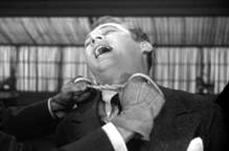When people think Alfred Hitchcock they probably think of Marion Crane’s horrific shower “accident” in “Psycho” or Cary Grant being aggressively pursued by a crop duster in “North By Northwest.”
If you’re only vaguely familiar with the man who inspired directors such as M. Night Shymalan and Brian De Palma, you would most definitely recognize his infamous silhouette seen throughout most of Hitch’s productions.
Like fine wine, Hitchcock’s films over the years have stood the test of time as the standard in suspense filmmaking. Considered to have been Hollywood’s greatest director, he did have certain films that have baffled critics; “Alfred Hitchcock’s Rope” is one of them. Made in 1948, “Rope” was Hitchcock’s first foray into color film. The movie also presented Hitchcock with a even greater challenge in trying to translate a stage play set in real time to the big screen.
“Rope” is based on the play written by Patrick Hamilton about two young men who murder their friend David Kentley (Dick Hogan) for the thrill of committing a murder and proving that intellectuals can and will get away with heinous crimes.
To further prove their superiority, the two men then decide to stuff their victim inside a chest and serve food on it at a party in which the guests include the victim’s father and friends.
While many of the guests are oblivious to what Brandon (John Dall) and Phillip ( Farley Granger) have done, their former teacher, Rupert Cadell (Jimmy Stewart), is not as easily convinced. Throughout the night he becomes highly suspicious of his two former students. This leads to a chilling climax that ranks right up there at the top of Hitchcock’s best.
Dall’s portrayal of Brandon, the most calm and charismatic one of the duo, is very understated. His characteristic blend of a cocky and demented sense of humor proves why he was the perfect choice for the role. His on screen chemistry with the angsty Phillip, played by Granger, is strong as well. Phillip is constantly caught between a moral crossroads in the film as he begins to worry if Cadell knows anything or what his partner will do next. Brandon treats their murder as a game and constantly pushes the envelope; Phillip is more reserved.
The back story of their relationship is that Brandon committed the murder in the first place based on the many teachings and discussions he had with Cadell about superior versus inferior beings. Cadell is suave and outgoing, much like Brandon, but the biggest difference their in morals.
Stewart, whom Hitchcock called “the everyman,” landed the roll after Hitch’s first choice, Cary Grant, turned it down. This would be the first in a number of collaborations between Hitchcock and Stewart.
Stewart played the part of Cadell straight up with no room for improvisation or preference. In the earlier stage play of which this film is based, Cadell had a torrid affair with the boys, a point that Stewart seemed to have ignored in his portrayal.
“Rope” from the beginning faced many problems as Hitchcock went about planning his first color feature.
Hitchcock had to keep the story in real time just as the play, shooting every scene in a series of 10-minute takes.
Hitchcock wanted the coloring to be just perfect and often reshot scenes where he thought that the color wasn’t as effective as he thought it could be. He also clashed with screenwriter Arthur Laurents who thought that the murder would be shown so as to heighten the suspense.
Like “Brokeback Mountain,” the implied homosexuality of the boys was too much for critics to handle as well as Laurents, who didn’t like the idea of Stewart playing Cadell, nor did he like his portrayal of the character. So by the end of 1948 the movie opened to modest box office success.
Since Hollywood has decided to only do remakes of Japanese horror films and biopics, check out a copy of this film. While it may not be as great as any of his later masterpieces, “Rope” is an undeniable exercise in suspense filmmaking and technique from the master.

